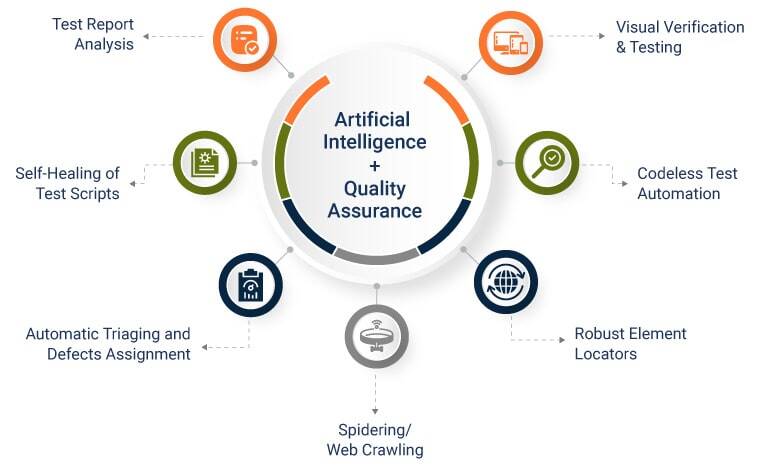
With recent trends in automated and digitized data acquisition, and deep learning algorithms, AI and ML applications are growing rapidly in fields that were initially to be solely managed by human expertise. By introducing AI and ML into automated testing tools, QA teams are able to address many of the conventional problems of automated software testing. According to a report by Digital Transformation Trends, 80% of businesses admitted that AI and ML improved their productivity, brand value, and ROI. And now, these two components have become an integral part of the software testing life cycle.
Organizations are focusing heavily on software quality to provide a better experience to the end user. Moreover, along with the focus on quality, IT companies are continuously exploring the latest technologies to speed up the QA tasks and resolve potential challenges in the QA ecosystem to deliver quality software in the shortest span of time.
Integrating artificial intelligence with test automation greatly helps to streamline testing efforts. Recent studies have proved that combining artificial intelligence and machine learning with test automation can further enhance the QA process in terms of speed, scalability, and quality. By adding support to these intelligent technologies to test automation, one can reap first-class automation benefits with minimum human intervention. Considering this fact, in this blog, we will discuss different stages of test automation and QA which can be supported with AI.
Implementing AI in Test Automation
There are numerous ways to utilize artificial intelligence in automation testing. Let us look into different forms of leveraging AI in the QA field:

-
Visual Verification and Testing
There is a big loophole in using automation tools like Selenium since they only work based on locator strategy, that is, these automation tools simulate human action on object locators only, and it does not verify the position and appearance of elements in UI. Moreover, although these tools are widely used, they do not perform the visual verification of the application.
Here, artificial intelligence algorithms can play a significant role to fill the gap. Machine learning, which is a part of AI, uses various patterns for the recognition and visual verification of elements. Few market tools use ML's power to add visual testing features in standard automation frameworks.
As an example, there is an AI-powered visual verification tool, called Applitools, which has been developed to ensure that the UI has been displayed correctly to the user. Also, every element is shown in the right color, shape, position, and size while ensuring that elements are not overlapped.
By utilizing ML-based visual validation tools, you can see the differences that a standard automation tool normally tends to miss. This helps to assert the visual correctness of the application along with the verification of its functionality.
-
Codeless Test Automation
Everyone knows that although test automation services saves a lot of human effort compared to manual testing, it still takes months, if not years to automate a complete web application.
To minimize this test automation effort, organizations are working on the development of codeless test automation tools, which have the capability to understand the business flows written in plain English language and run those flows as automated test scripts. This can save a lot of automation effort and help to minimize the dependency on automation engineers.
-
Robust Element Locators
With the advancements in UI technologies, dynamic and content-rich web pages generated by web development frameworks may look like a blessing for UI developers, but for test automation engineers it is more like a curse. The engineer's job becomes tougher when there are too many dynamic IDs and HTML DOM properties. Because of this, a stable test script, that defines an efficient web element locator is most important. When desired UI elements are not located properly, then most of the tests fail in automated regression suites.
But with AI, this job is less hectic and more robust for test automation engineers. If we can train an AI model on a large set of data from various websites, then it can create a weighted set of locators which can work better as compared to a single web element locator designed by automation engineers.
-
Spidering/Web Crawling
In the traditional automation approach, the test automation engineers manually develop the automation framework and then go through all the web pages manually to identify the UI elements for the development of object repositories and action methods. Further, a lot of time is consumed in the development of test scripts based on business logic, and it takes months or years for an automation team to automate a complete web application.
However, many tools are coming into the market which are utilizing the power of artificial intelligence and commit to automatically crawling the application to generate the test scripts within a week, which greatly helps to save effort and time.
-
Automatic Triaging and Defects Assignment
After the completion of a sprint in agile, it takes a long time for the development team to prioritize and assign the defects reported by the QA team. Moreover, it is a must-have task for every development team, as they need to ensure that high-severity defects should be fixed in the next sprint.
Here, artificial intelligence can play a major role in the automatic triaging and assignment of defects. An AI engine can automatically classify and prioritize the defects based on the bug severity and feature, and further helps a developer predict defects based on the previous assignment of defects. Moreover, similar defects related to the same feature can be assigned to a single developer to get the defects fixed in one go. This can save development teams a huge amount of time and effort.
-
Self-healing of Test Scripts
Maintenance of test scripts is a crucial part of test automation and engineers spend approximately 15-20% of the effort on the maintenance of existing test scripts. The failures can be due to multiple reasons like application speed, locator changes, false negatives, or missing test data.
Out of all the above-mentioned failures, artificial intelligence can help to save test automation cases in some particular cases. Let’s take an example: revamping is required of multiple test automation scripts whenever there is a minor change in UI. Here, AI can better differentiate between a "change" and a "bug", therefore AI frameworks are used to modify the script whenever a test case fails due to an update. Further, in case of any locator changes, the AI engine can suggest a new locator and can self-heal a test script.
-
Test Report Analysis
Test reports are the most important output of any automation effort. After every regression cycle, stakeholders analyze the final automation report to predict the health of the build. Machine learning can play an important role in the analysis of test reports and generate a predictive analysis about the build health based on historical and current reports. In this way, stakeholders can reap maximum benefits from test reports.
Top 5 AI-based Test Automation Tools
Following is the list of top five test automation tools which are leveraging artificial intelligence and machine learning, and provide ease to the end-users in the automation effort:
- Functionize: It is an AI-based tool that develops AI-powered tests using a smart agent and automates tests written in plain English language using natural language processing. Moreover, it supports AI-powered test maintenance and visual testing.
- Testim: This tool has an AI feature that eliminates the flaky tests, which eat into the resources.
- AccelQ: This is an AI-powered codeless test automation tool.
- Mabl: It is a low-code test automation tool, which enables the user to automate business scenarios with very less code.
- Applitools: This is a cloud-based automation tool, which performs AI-based visual testing on websites.
Conclusion
Artificial intelligence can reduce the need for human intervention and effort, but it might not completely resolve all the challenges or replace human beings. Some tasks can only be performed by humans like defining testing strategies, performing exploratory testing, and finding and running edge-case scenarios. However, QA engineers and AI can work hand-in-hand for the best possible outcomes. If you also want to incorporate AI into your test automation strategy, contact QASource experts now.
